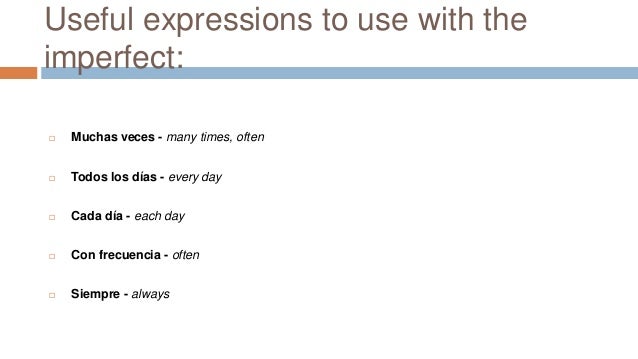
Quando vivevo con mia madre, mi preparava il pranzo quando tornavo da scuola. Īlla fine della giornata eravamo stanchi ma felici. Mentre facevo le fotocopie, Silvia scriveva gli indirizzi sulle buste. Non avevo animali in città perché non avevamo spazio in casa. Quando abitavo a Bologna con i miei genitori, non usavamo mai la macchina perché preferivamo la bicicletta. The imperfect (imperfecto) is one of the two simple past tenses in Spanish. Also, what is the imperfect tense in Spanish used for Imperfect. ser, ir and ver are irregular in the imperfect. The conjugation of a verb in the imperfect is not normally a difficulty, but you may initially hesitate as to whether to use the imperfect or another past tense.īut first, the conjugations! Here are some examples of verbs conjugated in the imperfect:Īlmost all verbs are regular in the imperfect, but there are some very common exceptions:īelow are some sentences showing how the imperfect tense is used, along with English translations.Īs you will see from studying them, different English tenses can be used to translate the Italian imperfect form, but the core meaning is always of the ‘past habit’, ‘past state’ or ‘past action in progress’ type.ĭa piccolo vivevo in campagna in una grande fattoria. To form the imperfect tense of -er and -ir verbs, take off the -er and -ir endings and add the endings: -ía, -ías, -ía, -íamos, -íais, -ían.

This typically narrative tense describes actions. This is the only place where the imperfect aspect is formally distinguished from the simple aspect (that is, the Present Tense serves both for the Simple Present and the Present Imperfective, as does the Future Tense).
#Imperfect endings trial
Eventually, there was compromise and courage, and Zoes mother had her happyif imperfectending. Imperfect Endings: A Daughter's Tale of Life and Death Hardcover Maby Zoe FitzGerald Carter (Author) 49 ratings See all formats and editions Kindle 13.99 Read with Our Free App Audiobook 0.00 Free with your Audible trial Hardcover 12.47 45 Used from 0.91 6 New from 5.99 3 Collectible from 30. The Imperfect tense typically refers to the imperfect aspect in the past time. (ser, vivir) When I was little, I used to live with my family in a country house. Fill the gaps conjugating the verbs in brackets in Imperfect Tense: 1) Cuando yo era pequeo, viva con mi familia en una casa de campo. – when talking about actions which were taking place at the same moment For months, the decision dragged on as her mother changed her methods and schedule, and the negotiations stirred up old memories, sibling rivalries, and questions about family loyalty. This exercise is about using the Imperfect Tense for habitual actions and ongoing situations in the past. – to describe physical or psychological states in the past – to describe people, animals, places and situations in the past But these verbs do sometimes occur in the preterit. Some verbs occur more frequently in the imperfect when they are in the past since they typically describe states of being: ser, tener, estar, gustar, etc.

Good news! There are only three irregular verbs in the imperfect. The imperfect tells when - in general, an action occurred. Use of the imperfect tense implies that the past action did not have a definite beginning or a definite end.

Remember, the imperfect is used for past actions that are not seen as completed. Subjunctive VIII: Actions not yet completed Subjunctive III: Verbs that change orthographically In order to conjugate verbs that end with -er in the imperfect tense one must: Find the infinitive (full verb) Cut off the -er. Subjunctive II: Conjugating regular and stem-changing verbs There is a three-step method that will make conjugating regular Spanish er verbs very easy for you.


 0 kommentar(er)
0 kommentar(er)
